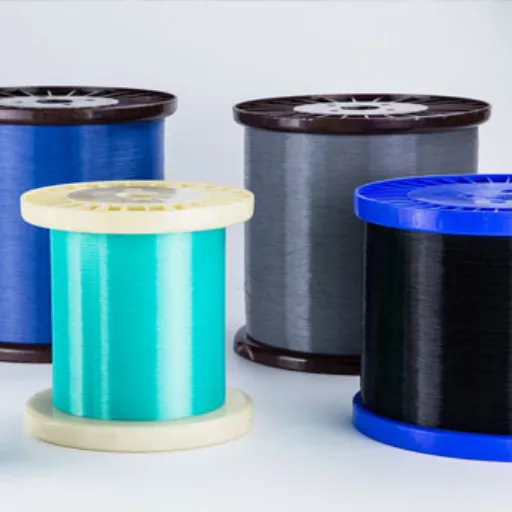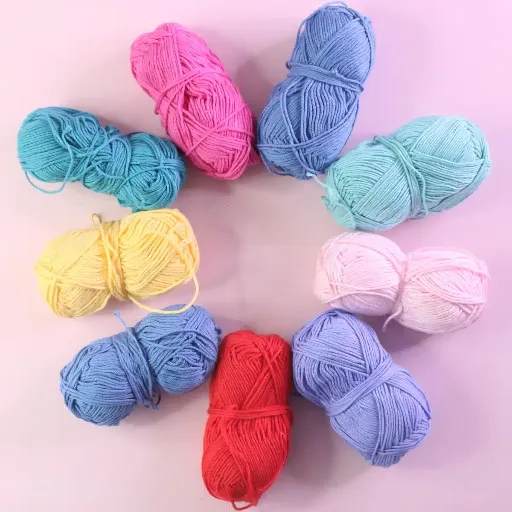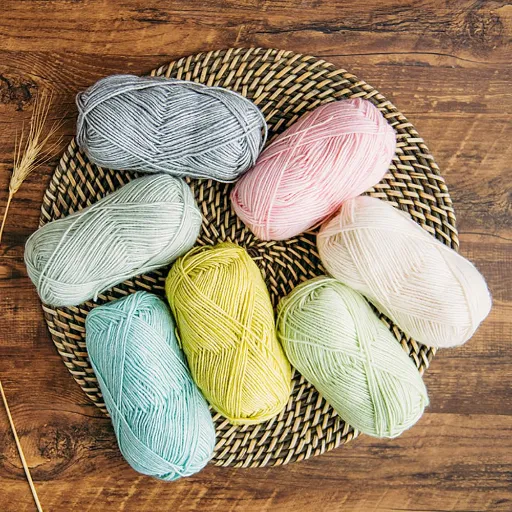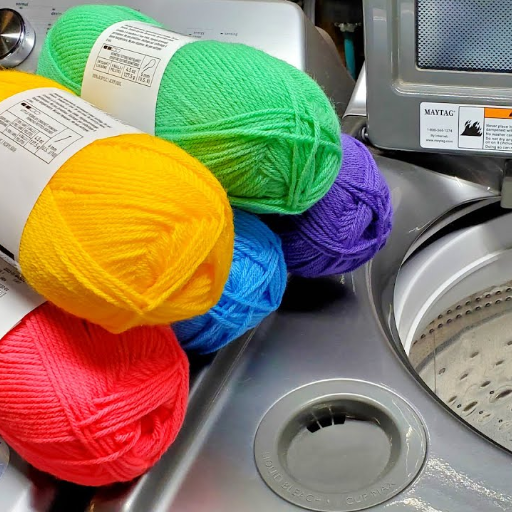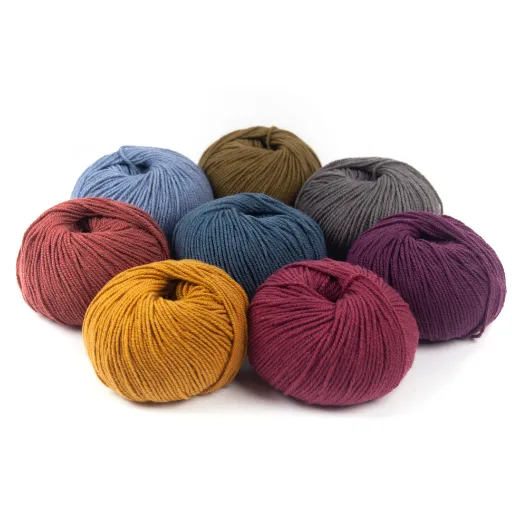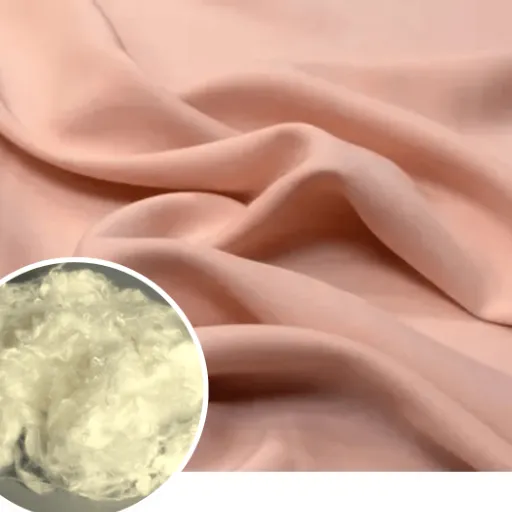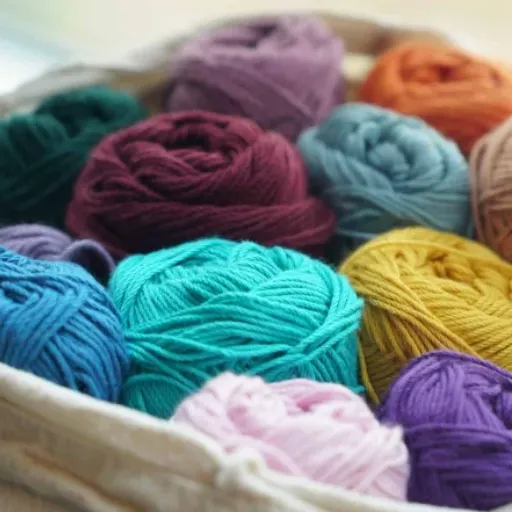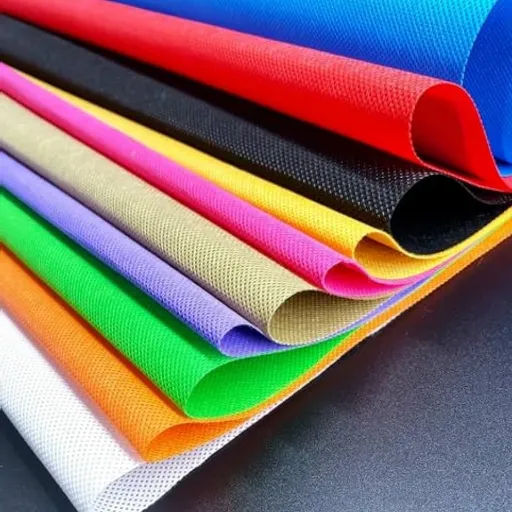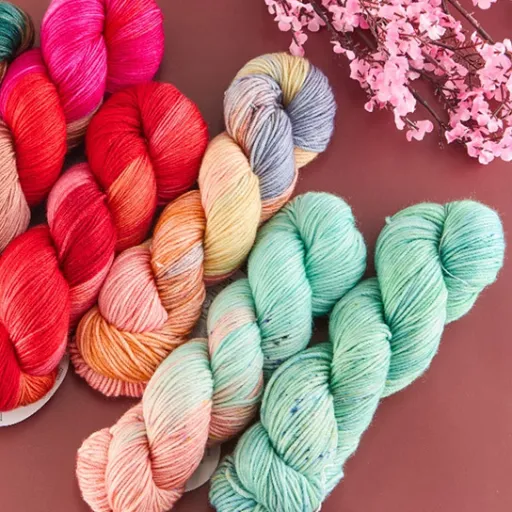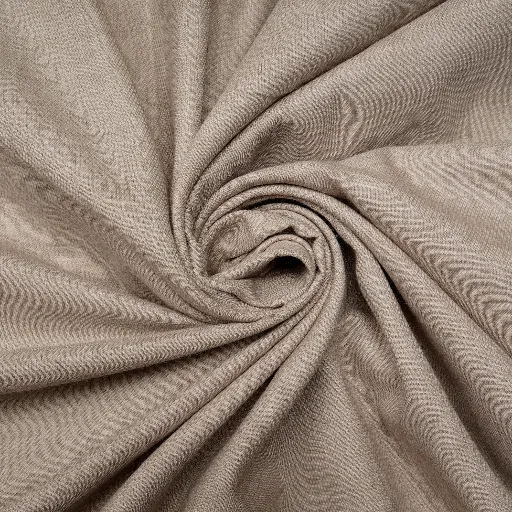When comparable with synthetic fibers, polyester and acrylic yarn are considered very basic fiber brands in the world of crafts and fashion-they are quite literally metal forces working against each other. Each has a good name, yet which one truly fills your needs in crochet projects or everyday clothing? For a seasoned intriguer, or even a novice who is just trying to figure out some sustainable and durable fiber alternatives for their work, one must have a grasp on the differences between polyester and acrylic yarn to be able to make well-informed decisions. This guide casts the spotlight on the features, applications, and benefits of these two popular fibers so that you have an edge while deciding on the best fit for your particular project. Add more to keep track of the pros and cons of each and finally find out which synthetic fiber is truly number-1 for style and comfort paired with practicality.
Understanding Yarn Types
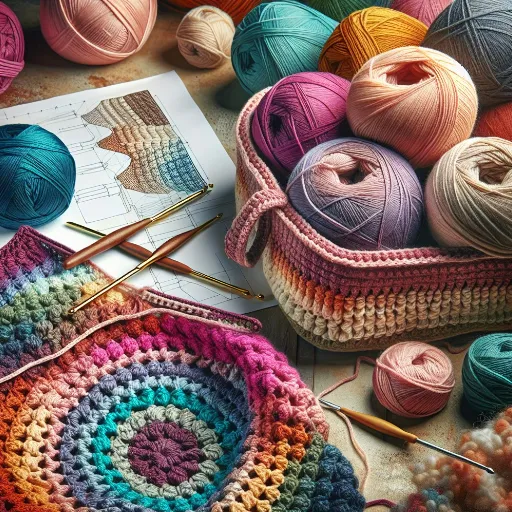
What is Polyester Yarn?
Polyester yarn is a synthetic fiber produced from petroleum-based products. It is more durable and strong than any fiber; it has very little shrinking or stretching. The yarn undergoes polymerization in which present chemical compounds are melted, spun to fibers, and then woven into yarn. Being synthetic, polyester yarn offers mildew-fighting, fade-proof, and anti-wrinkle properties, making it an excellent option for the highest number of other applications.
Another advantage offered by polyester yarn is that the material is very versatile and useful for knitting, crocheting, and weaving. It is commonly used in items for apparel, accessories, and household décor because it feels soft and holds color very well. It is also great for everyday wear as it is easy to maintain-washable in the machine and dries fast.
Polyester yarn faces the downside of trapping heat sometimes, and hence it is less breathable and entails less comfort in those warmer climates. From the perspective of an environmental point of view, some might view it differently, believing that, being petrogenic and taking forever to decompose, it is harmful. Yet, with the improvements in recycling treatment, making polyester a sustainable option for those in need of a durable yet affordable material.
What is Acrylic Yarn?
Acrylic yarn is a synthetic fiber spun from a material called acrylonitrile, which in turn is derived from petroleum or natural gas. It is made by polymerizing acrylonitrile to produce an ultra-lightweight fiber that is mercifully durable and highly adaptable and resembles the texture and appearance of wool. Being synthetic, acrylic yarn is designed to be price-friendly and easily available, while also retaining softness and warmth.
Creative advantages that acrylic yarn has in its end product include ease of care. It can be safely machine washed, does not hold wrinkles, and remains colorfast even after repeated washings. This made it a beloved choice for beginner crafters as well as for professional users who look for fast and enduring crafting materials. Another plus for acrylic yarn is that it is hypoallergenic, hence a suitable option for those who have sensitivities towards natural fibers like wool!
In addition to all the mentioned benefits of the acrylic yarn, it too has a couple of notable inconveniences. For example, being less breathable than natural fibers, considers giving uncomforting sensations during summer. Another limitation is that, from petroleum, it is derived; thereby, a lesser ecological value is held by acrylic yarn as compared to natural and biodegradable fibers. There are ever-improving recycling technologies tending to mitigate these concerns; thereby acrylic is fast becoming a greening option that shops well with any eco-conscious mind.
Differences Between Polyester and Acrylic Yarn
Thus, polyester and acrylic yarns are synthetic petrochemical fibers that differ in many respects-13 from which they best serve and are selected by uses and preferences. Polyester yarn is famous for its superior durability and resistance to chemical damage; hence it is used anywhere where performance must remain superior for longer periods, such as in outdoor fabrics, upholstery, and activewear. On the contrary, acrylic yarn is seen as softer and warmer and hence roundly preferred for projects such as knitting sweaters, blankets, and scarves.
Durability and Longevity:
The resilience of polyester exceeds that of acrylic. It stands the test of vigorous washing, abrasion, and protracted exposure to sunshine better, with hardly any degradation. Even if acrylic is claimed to be strong, it somehow gives way to the wear and tear with time, especially if it is considered in contrast to polyester.
Texture and Feel:
An acrylic yarn is in general softer and more woolly in feel, with echoes of the warmth and natural pleasant touch of a fibre. The usage of acrylic is quite popular when comfort is desired in the end product-Native wool being quite expensive. A polyester is smooth but is more rigid and less warm or comfortable with acrylic.
Moisture-Wicking and Breathable:
The moisture-wicking properties belong to the underpolyester, meaning it repels moisture rather than absorbing it. This is an excellent trait when considering sweat management while making sportswear and activewear. Because acrylic is less breathable, it absorbs moisture quickly-more moisture and less air are not suitable in places where moisture control is needed.
Cost and Environmental Impact:
But on either side, we work with cheaper investments, although they do have different environmental consequences. Polyester generally has a lower ecological footprint during production when compared to acrylic, which consumes a lot of energy to be produced. However, the improved recycling technologies now allow for the repurposing and reuse of both materials. For example, recycled polyester is currently made from plastic bottles, which helps minimize waste and saves the environment. Acrylic recycling is less common but continues to grow, minimizing the overall footprint over time.
Characteristics of Polyester and Acrylic Yarn
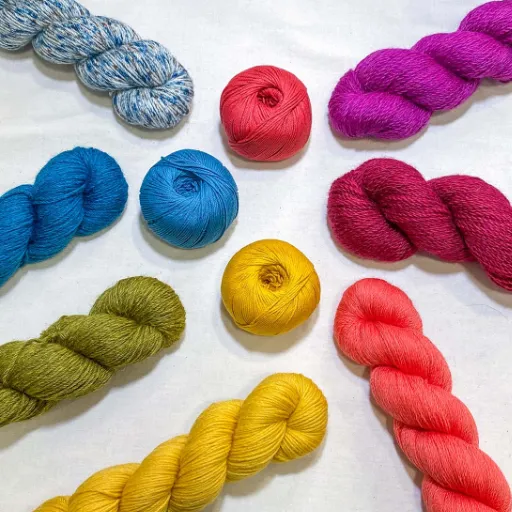
Characteristics of Polyester and Acrylic Yarn
Texture and Feel
The polyester yarn has a fine smooth finish. It is lovely to wear for cloth and home textiles. Being synthetic in nature, polyester has a very broad spectrum of production varying from very lightweight to thicker, highly durable fabrics. Some slight slickness or coolness is typically felt by polyester fibers when compared to natural ones, so it is a very popular choice to be blended with other fibers for an improved feel.
Conversely, acrylic yarn can be warm and soft, almost resembling the feel of wool. It is light and fluff would generate an apt apparel for cold weather, blankets, and accessories. The acrylic counterpart sometimes might feel less breathable because of being synthetic but that very go-ahead for the alternative applications is its own coziness to care for.
Polyester and acrylic yarns develop special textures that have all kinds of different properties useful for the different needs and preferences of people. The polyester weaves are valued for their durability and smooth finish. In contrast, acrylic yarn is cherished for warmth and that snuggle-like feeling akin to wool. The choice between the two depends on how the product will be used, how it should feel, or what the finer points of a project demand.
Elasticity and Durability
When talking about the elasticity and durability of polyester and acrylic yarns, both materials possess their own advantages. In terms of polyester yarn, it is well known it provides a lot of resistance to wear and high strength, therefore, good or excellent for work that demands durability. For elasticity, polyester tends to possess moderate values; thus, giving the final product slight stretching with little shape loss on aging. This becomes very handy when the polyester yarn is advocated in the production of garments or home décor items subjected to frequent use.
Acrylic yarn, in contrast, is more soft and flexible but hardly ever as durable as polyester. The other face of the coin of its elasticity would be zing more stretch and transfigure. This gives acrylic an advantage in winter wear, blanket projects, or any other project that benefits from warmth and comfort. However, doubt could arise about its integrity-lost potential with constant depending on others compared to polyester, mainly on repeated use and wash.
Ultimately, it depends upon the requirements of your project when opting between polyester and acrylic yarns. Polyester will have an edge on acrylic when emphasis is placed on longevity and shape retention. For softness, comfort, and stretch, your best choice will probably be acrylic. Based upon the applications and the qualities needed for the application, the best choice for you will be the one that meets your respective goals.
Sheen and Appearance
The sheen and appearance of polyester yarns and acrylic yarns differ considerably. A polyester fiber usually comes with a natural glossy finish, which imparts a sleek and polished look to the material. It is for this reason that polyester is often an ideal choice for projects that need a chic, modern look. The sheen of polyester is super-resistant and doesn’t fade and so is the visual effect of the material made with long-term applications.
In contrast, most acrylic yarns tend to have a softer matte finish and somewhat more natural look. If a project seeks the warmth of a non-reflective sheen, then acrylic would be the best choice-such as in the case of home decor or winter accessories. Besides, acrylic yarns are readily available in any color and texture one can think of, thus making them a bit more useful for design needs, especially for extremely bright color requirements.
The selection of polyester vs. acrylic for sheen and appearance should depend on the type of outcome needed. If the very shiny smooth finish of, and an appearance of maybe, it conjures connotations of elegance, polyester is your obvious choice. On the contrary, if your project tends to favor softer hues with a subtle visual impact, then acrylic yarns would certainly be appropriate. Both, of course, bring along specific advantages, but ultimately the decision will gravitate more toward aesthetic goals and the application itself.
Common Uses in Different Industries
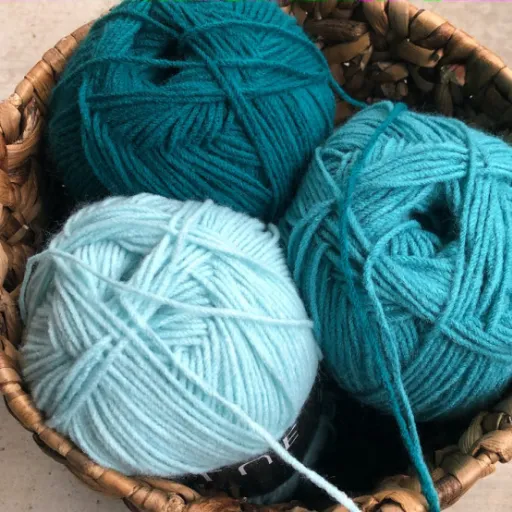
Fashion and Clothing
Here are some points to explain their varied textile usages. Polyester is the tougher fibre that does not wrinkle, absorb moisture, and best suited for active fabrics, outer fabric, and a little formal wear. Because they are lightweight and can be anthracotechnically dyed, the colour is not only bright but long-lasting.
Acrylic, on the other hand, is mostly used for knitwear, such as sweaters, scarves, and hats, owing to its soft and warm texture. Generally, it is used as a substitute for wool on account of its being less expensive, hypoallergenic, and easier to maintain. Thus, thereby being a little more weight to be rendered away in terms of shrinking, acrylic wears are a good option for everyday wardrobes.
The versatility in both materials caters to different needs in the fashion industry. Polyester is cherished for its practicality and durability, whereas acrylic excels at providing comfort and warmth. Designers and manufacturers may select either one of the two, depending on the specifics involved in making the garment and demands of the usage.
Home Décor
Polyester yarn has increasingly moved into the limelight as far as home decorating is concerned due to durability and affordability, along with a high degree of versatility. The main applications it finds are in the making of rugs, curtains, upholstery, and decorative pillows, thanks to particular qualities such as absorbing little moisture and retaining colors quite well even after some years. For instance, a recent statistic mentioned that in textiles that are used very intensively, polyester yarn can stay up to 5-7 years, giving an ample duration of use to establishments having a great flow of traffic or continuous usage. Polyester materials are highly resistant to fade, therefore making them a perfect selection for outdoor decor items.
Though polyester yarn is not considered biodegradable, new recycling methods have been developed so that the used polyester materials can be recycled, thereby contributing towards sustainability programs. To any decorator who values style and functionality on a tight budget, polyester yarn remains a good faithful choice that balances performance with price.
Crafting and DIY Projects
Polyester yarn is highly preferred for crafting and other DIY projects because of its high versatility and strength. It finds application in a wide spectrum of works under crocheting, knitting, and weaving, provided it remains lightweight, sturdy, and easy to manipulate along the process flow. Polyester yarn is very good at holding dyes, thus providing crimson, further-defined, and long-lasting colors for your creation, whether it be for home décor, garments, or accessories.
The major advantage of polyester yarn in DIY applications is its resistance to wear and tear and environmental factors. It makes it a good choice for either indoor or outdoor items such as rugs, cushions, and wall hangings. Being low-maintenance, it allows the creators to keep things simple in terms of cleaning and upkeep, without sacrificing on quality or looks.
Additionally, polyester yarn offers a somewhat cheap alternative for crafters of every quarter. Price-wise, polyester yarn is very inexpensive, and on the other hand, it is easily found in stores and shops. Polyester yarn, when thrown into the mix, can make the crafting world beautiful, yet Prudent in its choice.
Choosing the Right Yarn for Your Project
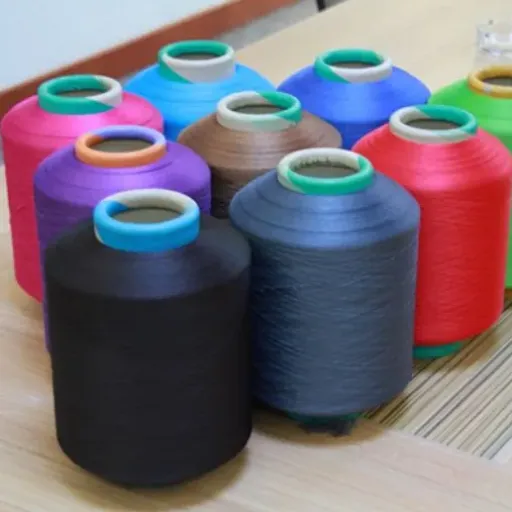
Factors to Consider
Choosing the yarn appropriate for a particular project is governed by an array of factors crucial for the end result’s satisfaction according to one’s expectations. Here are a few important considerations with some relevant information and data:
Fiber Type:
Fiber types more than affect texture, durability, and the suitability for the project itself. For an example, natural fibers such as wool and cotton dry up being suitable, flexible, and breathable for clothing. Synthetics on the contrary, offer polyester and acrylic for their relative cheapness and very easy maintenance.
Weight and Thickness:
In particular, yarn weight will determine the look that will be given to the project. From the most common are lace, fingering, DK, worsted, and chunky, each with different applications. For instance, chunky weight is well suited for nice and warm woolly blankets, while fingering weight is preferred for lighter shawls.
Color Vibrancy and Longevity:
The color selection of yarn should perfectly go with your conceived design and stand the test of time. Natural fibers would usually offer softer, more neutral shades, while synthetic yarns are the brighter ones.
Cost and Availability:
Costs always came into consideration in the process of yarn selection. The question arises, would the cheaper synthetic like acrylic and polyester yarns be the more cost-effective one, and can they be found easily? Luxury fibers like silk, alpaca, or cashmere, on the other hand, tend to skyrocket your expenses. The present-day market from major craft retailers puts a lipstick price of somewhere around $3 a skein for the acrylic yarns, and upward of $20+ for the luxurious natural fibers.
Where Project Demand Comes into Play:
It will really depend on what your project will be used for. For instance, baby clothes can require something a bit lighter and hypoallergenic, whereas rugs will need something probably a bit coarser and tougher! The craft world is generally united in the opinion that matching the properties of the yarn to its intended use results in a far better end product with greater longevity.
By weighing all of these factors, you can really decide on the right yarn for your artistic vision and ensure that beauty is not sacrificed for functionality.
Recommended Crochet Patterns
Crochet projects take from the traditional simple yarn and make attractive creations. A beginner should start with simple projects like dishcloths, scarves, or granny squares. A few of these projects help the crocheter in attaining the basics-little stitches like single crochet, double crochet, and chains, while also offering something useful to hold onto. Such patterns are simple and forgiving, best geared toward learning and gaining confidence.
Patterns like shawls, baby blankets, or hats are considered intermediate level and are suitable for more complex procedures. They often use some difficult stitches or require shaping techniques just enough to challenge. These projects will further be a means of testing your abilities with texture and color, so these skills can be exhibited while making warm memories with your hands.
Intricate lace doilies, sweaters, and bedspreads would be interesting projects for advanced crocheters. Usually, advanced patterns require an intricate working knowledge of advanced stitches, shaping, and working techniques; working in the round or working in motifs, to name a few. Such projects test one’s application of patience and sense of detail while an amazing piece of work stands as testimony to the talents and hard work of the maker. Irrespective of one’s levels of expertise, picking patterns that suit one’s ability level goes a long way in ensuring the process is enjoyable and satisfying.
Tips for Selecting Yarn Content
The act of selecting the yarn becomes an important step in allowing the project to succeed, for this affects the look, feel, and strength of the final piece, as well as the comfort with which one can wear it. Below are some useful tips and considerations when buying yarn:
Fiber Type:
Different yarn fibers serve for different purposes. Natural fiber-yarns such as wool, cotton, or alpaca-give warmth, breathability, and softness, respectively, while acrylic and nylon are cheap, lightweight, and wear-resistant. Organic or recycled yarns are increasingly available to the environmentally conscious crafter, combining sustainability with functionality; for example, in 2023 some emerging brands are sustainable, plant-based fibers such as bamboo or Tencel.
Yarn Weight:
Yarn weight determines the diameter of the yarn strand, with a direct effect upon the size, drape, and gauge of the project. The Craft Yarn Council has established standards for the weights, ranging from “0 LACE” being the lightest to “7 – JUMBO” being the heaviest. The recommended yarn weight should always be checked in a pattern, and very much so, for if a wrong weight is used, it might change the whole appearance and usability of the object.
Color Considerations:
The color of the yarn affects the different aspects of the overall look of the object. While solids can usually be worn with anything, variegated, gradient, or self-striping yarns impart much more movement and character. For complicated stitch patterns, lighter or solid colors are best, as these yarns will show off the work better than dark or busy-color yarns.
Texture and Ply:
Working with yarns involves texture and ply that affect working comfort and stitch display. Smooth, sleek, tightly plied yarns are good for beginners and intricate patterns, while textured or novelty yarns like boucle or chenille add interesting accents but might be a little hard to handle.
Yardage and Budget:
Measure your required yardage for the yarn according to the pattern so as not to run short in the middle of the project. Buy value packs or look for yarn sales to keep it cheap. The average price for 500 yards of wool may be $20-$40, depending on quality and vendor.
Allergies and Comfort:
If the item that is to be made remains in contact with the skin, those fibers will require some consideration for hypo-allergenicity and softness-related properties. Some persons could be allergic to wool and choose cotton, silk, or acrylic.
With those factors considered, the crafters make sure that they have picked a yarn suitable for the demands of the project and for their own choice. Making a swatch for test purposes before buying a huge quantity is really good just so the crafter can be sure the yarn actually behaves in texture, color, and performance.
Caring for Your Yarn Projects
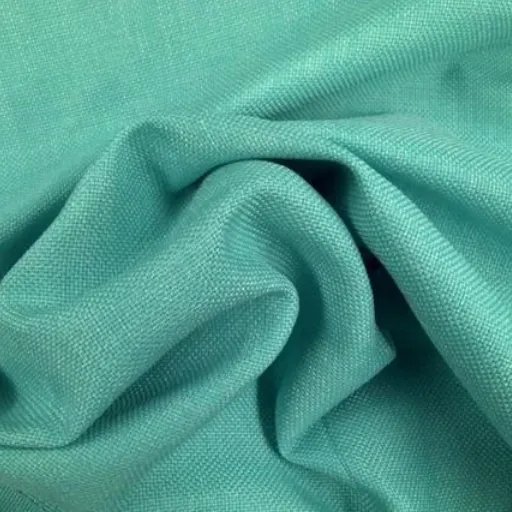
Washing and Drying Guidelines
Yarn projects deserve utmost care to maintain the utmost quality and durability. Always consult the yarn label to find the precise care instructions, since there are many requirements, dependent upon the yarn type, for washing and drying. For instance, natural fibers, such as wool, generally need to be hand washed in cold water with a very mild detergent to avoid felting or shrinking. In contrast, synthetic fibers, such as acrylics, are stronger and typically safe to be washed in the machine.
Hand washing requires the soaking of the item for a few minutes in lukewarm or cold water with a neutral detergent. Get rid of the water by pressing the item with your hands; never wring or twist it, for that causes damage to the fiber. Machine washing requires the delicate cycle in cold water, and the item goes into a mesh laundry bag to ensure protection. Never use harsh detergents or bleach, since these would break down the fiber and cause color fading.
Yarn medium-drying is achieved by laying the project sprawled out on a clean towel and reshaping it gently to the original dimensions. Rolling the item up with a dry towel and pressing lightly might help in removing extra moisture. Never hang the item to dry; operating thus might cause it to stretch. When permitted by the type of yarn in use, tumble drying at a low setting is another option. But always make sure you check the care instructions for your yarn first. These steps will help maintain one’s handiwork in great conditions for long.
Storage Tips for Longevity
Proper storage is essential if your handmade items are to remain in good condition. Remember to always store your items in a cool, dry environment away from direct sunlight since prolonged exposure to light causes colors to fade and fibers to wear out. Items should be placed in cotton or linen bags because plastic bags are not advisable for this purpose; plastic traps inside moisture and encourages mold or mildew growth.
Ensure the items are clean and dry before storing; else, unpleasant odors or stains may have time to develop. When folding, place only slight tension and avoid stacking heavy objects that might be detrimental to shape. Consider some form of barrier such as acid-free tissue paper between items when storing more than one, to prevent transfers or snagging.
It is advised to furnish storage with cedar blocks or lavender sachets as these natural repellents keep moths and other insects at smell-away distance minus harsh chemicals. Regularly check on your stored creations to keep them healthy; do whatever is needed to preserve them from dampness or bug activities, which will keep the beauty and quality of your handmade creations safe with you for many years.
Repair and Maintenance Advice
Proper repair and maintenance of handmade objects will help to increase their life. Any loose threads and small tears must be dealt with immediately. Use a needle and thread that correspond to the original material to stitch somewhat carefully. For a severe case of damage, it is better to consult a tailor or repair specialist who can restore the item properly without further damage to it.
Regular washing is also one way to keep the wholesomeness of any handmade creations. Be sure of the material’s instructions for cleaning, as some may require very gentle washing or even just spot cleaning. When washing, always use gentle detergents, steering clear of chemicals that might harm the fibers or cause fading. Handwash in cold water is the norm for any delicate article. Air-dry the articles to prevent shrinkage or distortion and store them away from direct sunlight to keep their colors vibrant.
Lastly, protect them against long-term wear and tear by handling with care. Use a rotation system so that some items are overused while others go loose, and seek cool, dry places free of pests and excess humidity. Follow these repair and maintenance tips to ensure that those handmade paintings stay looking great and working for years.
Frequently Asked Questions (FAQ)
Q: What are the main attributes of polyester yarn?
A: Loading polyester yarn is durable, resistant to shrinking, and it holds its shape well. It is a synthetic fiber that gives a downy feeling; other uses include garb and upholsteries.
Q: Can you make socks from polyester yarn?
A: According to the opinion of some, polyester yarn is really good for making socks, whereas, moisture-wicking capabilities give it an edge of being an even more excellent materials. It can stand under extreme conditions and also has applicability for the durability of sock patterns with less chance of pilling when compared with other fibers.
Q: Polyester yarn versus acrylic yarn?
A: Polyester yarn and acrylic yarn share several attributes-synthetic nature and cheapness are among them. But the polyester would be more durable and very resistant to wear, while acrylic could be softer. It depends very much on what you want to do with your project, really.
Q: Any disadvantages of polyester yarn?
A: Though polyester yarn preeminently possesses many good points, it may feel less breathable when compared to natural fibers. This becomes unsuitable for some projects meant for warm weather areas, but it remains versatile for many uses.
Q: Can polyester yarn be made for use in crochet patterns?
A: Of course! Polyester yarn is one of the most common yarns used for crochet patterns because it is easy to work with and comes in multitudes of colors. Its strength ensures that the finished products hold shape and the projects used for making will include things like gloves and hats.
Q: What kind of projects usually favor the use of polyester yarn?
A: Polyester yarn is employed in a wide variety of projects ranging from clothing and accessories to home decoration. Its harsher durability makes it beneficial for use in the making of items like blankets, bags, occasionally even outdoors equipment that might be thrown through extreme conditions.
Q: Is polyester yarn suitable for a beginner?
A: Yes, it is a well-recommended yarn for beginners, due to its ease of use and easy availability. It rarely frays or splits, which means new crafters need not expend effort trying to fight with difficult fibers but rather need all of their energy to be poured into actually learning.
Q: How do I go about caring for objects made in polyester yarn?
A: Looking after items made in polyester yarn is not so complicated. Most of the items can be machine washed on a gentle cycle and tumble-dried on a low heat. However, always look out for care instructions to make sure your projects will last.
References
- What is Polyester Yarn Good For? – Discusses the versatility and affordability of polyester yarn, especially for beginners and garment-making.
- Polyester Yarn vs Acrylic Yarn: Which Synthetic Fiber is Right … – Compares polyester yarn to acrylic yarn, highlighting its durability, quick-drying nature, and resistance to stretching and shrinking.
- 8 Basic Facts about Knitting with Polyester Yarn – Explains the benefits of polyester yarn, such as wrinkle resistance, ease of care, and elasticity.








